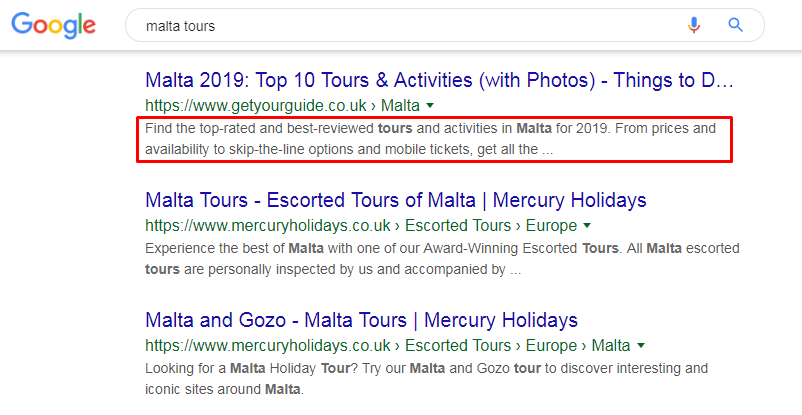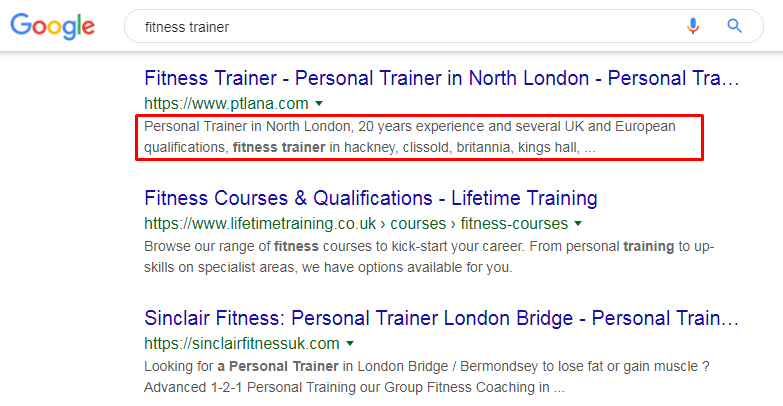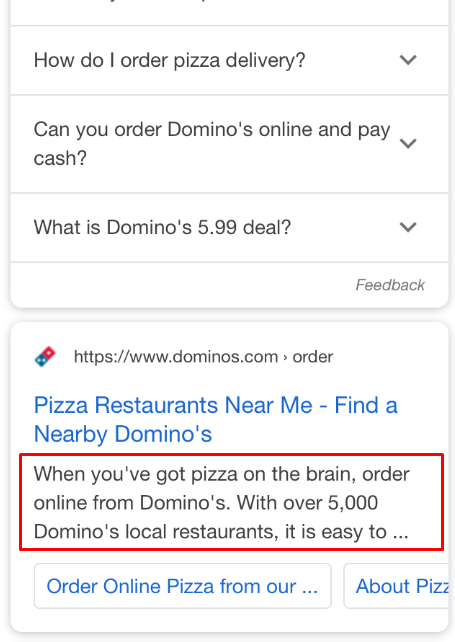Using the description meta tag, you can create a description of the web page that will be available to both a user and the search engine robot.
Why do you need to fill in the description meta tag
This meta tag should contain the most important and key information about the page which is its brief description. The use of the description tag is not mandatory when filling the website with content.
If there is no additional information about the page in the meta tags, the search engine will generate a description text itself in response to a user's query (this often happens in information queries when the description is filled in).
Using meta tags allows you to independently determine keywords and text which will be a description of the website page. This expands the possibilities of website optimization; you can cover more key phrases that are prospective in terms of optimization.
The description tag also makes it possible to generate a relevant, selling and user-friendly snippet in the search results.

The role of description for the SEO
A meta description of a page is an easy way to reach more key phrases. Using meta tags and content, you can create a semantic profile for each page using popular user queries in this subject and distributing them between description tags of the entire site. Thus, you can expand the total number of keywords of a web resource, embrace a larger semantic kernel, and increase website visibility.
The page content often contains keywords, for example, in the description of products and services, in articles or reviews. However, these phrases are often low-frequency, and some of the popular and targeted queries may be missed.
The advantage of using the Description tag is that the specialist independently adds those key phrases in the tag that are the most perspective from the optimization viewpoint.
At the stage of page scanning, the search robot in the <head> element detects meta tags, and the website's visibility in response to relevant user queries is increased.
The description meta tag is usually filled in via the appropriate input fields in the website admin panel. Certain CMS contain meta tag options in the page settings. SEO plugins also provide this feature. The registered and saved meta tags appear in the <head> element of the page and, after the next indexing, begin to fulfill their function.
The role of description in snippet formation
The use of key queries in the description is not only an optimization tool that allows you to increase the visibility of the website for targeted queries, but also a way to determine what a user will see in the search results.
After entering the query in the search engine, a list of website snippets appears, each of which corresponds to a certain structure. Normally, this is the title of the page, a link and a brief description of its contents.
If the Description meta tag is empty, the search engine will generate the description itself. Since the page description allows a relatively large number of characters, you can see fragments of content in it that have little to do with the user's query in addition to the keywords highlighted in bold.

The task of the SEO specialist is to effectively use the allocated character count of the description tag and determine the priority information for the description in the snippet. Thus, you can make a nearby link environment in organic search commercially attractive and increase the website CTR.
How to choose a correct SEO description length
Relevance to the page
Meta tags must first be relevant to the page content. In the description tag, you should use those keywords that will make it clear to a user that they found what they were looking for and will meet their expectations when going to the website.
Optimal format for SEO performance
You can include key phrases that did not fit in the Title tag or the H1 heading in the description. It is advisable to use high-frequency and mid-frequency queries in the description, placing them at the beginning of the tag. Do not duplicate the same keyword. It's better to pay attention to the "tail" of the description which is the information about competitive advantages and to add a call to action (CTA).
No repetitions
As with the Title tag, the meta description of each page on the site must be unique, so attentively check your site. Also, copying Title text into description or vice versa is not allowed. Meta tags make it possible to make the semantics of the website as wide as possible, and duplication is unacceptable for high-quality internal optimization. Check all descriptions on a website to make sure they don't repeat.
Optimal Google meta description length
The description tag is the largest among meta tags. However, there are certain meta description character limits that should be followed.
How many characters to use in meta description
The visible size of the description in the snippet may vary depending on the search engine. The standard Google description length is 150-160 characters. You can check it by using a meta description length checker.
The maximum SEO meta description length can be up to 300 characters. As with the Title tag, the words indicated in the "tail" of the description and hidden in search results can affect the website ranking.
Therefore, the Description tag can exceed the recommended length of 160–170 characters. The main thing is to specify the keywords at the beginning of the description, placing information in a meta tag from beginning to end as it is prioritized.
In general, the recommended meta description character length allows you to include the most important information in the description: about the product or service, brand, website subject, and price as well as add a call to action or other selling information.
How to increase the snippet clickability
In addition to adherence to the basic principles of description formation and adding keywords, there is an additional indicator of optimization efficiency which is behavioral factors. It is important not only to achieve that your website pages are displayed in search results but also to encourage users to go to your web resource and stay there.
To increase the CTR of a page, you need to make its description as attractive as possible. A snippet can be compared to a business card or a small advertisement that should captivate your attention. Do not overload the description with keywords; 1-2 queries are enough.
The description text should be clear, structured, and contain information about competitive advantages. You can include a phone number there, as well as indicate the price of a respective product. A call to action will be an additional way to influence the snippet CTR, for example: "Buy a closet at an affordable price" or "Order pizza with free delivery".

Depending on the query, the intent of the user, and the content provided in the snippet, your click-through rate can increase. The optimal length for the description is 155-260 characters. Don't make it too long, but at the same time, don't make it very short - just stick to the recommended length and your website will be fine. Take a look at some more SEO description length examples to have an idea of what a description should look like.


Conclusion
Filling meta description in SEO is an important stage and an additional way to use keywords when optimizing it in search engines.
The recommended meta title and description length is 160-170 characters, however, the total size of the description can be up to 300 characters, including the visible and hidden parts. Use meta description length checkers to make sure it is well-optimized.
Effective use of the description volume will help to achieve the best results in terms of the website SEO, as well as the relevance and attractiveness of the page description in the search results.
